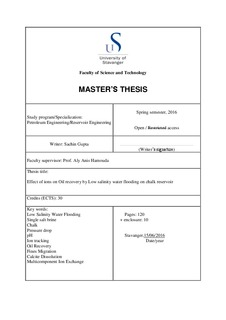| dc.description.abstract | Low salinity water flooding has shown its potential for incremental oil recovery. It has been widely researched Oil Recovery method. However, the mechanism of the method has not fully understood. This is mainly due to complexity of rock/brine/oil interaction.
In this paper all the experiments were performed on Stevens-Klint Chalk, Denmark, which were initially saturated with model oil {N-Decane + Stearic Acid (SA), 0.005 mole/l} and Crude Oil X, from North Sea field. Different LSW were investigated here with emphasis on understanding the role of some ions that were recognized form our previous work as well as literature on their effect on wettability alteration.
The flooding fluids were synthetic sea water (SSW) and the diluted SSW by 10 (LSW1:10) and 50 (LSW1:50) times, single and two salts brines, such as Na2SO4, MgCl2, and NaCl+MgCl2. at 70˚C. SSW was used as the primary flooding fluid, while other flooding fluids were injected as secondary flooding fluids to estimate the potential incremental oil recovery. This is mainly due to the fact that most of the fields are flooded with seawater. Injection rates effect (4PV/day and 16PV/day) were also investigated, following the changes of the pressure drop, effluent ion concentrations and pH.
An increase in pH was observed during flooding with LSW and single salt brine flooding. Increase in pH is attributed to mineral dissolution which is demonstrated by ion tracking results. Few aspects were observed: 1) As dilution factor increases, slower response in oil recovery observed. 2) In presence of SO42-, Ca/Mg enhances the sweep efficiency. 3) It is interesting to observe deficiency in [Mg+2] in effluents than injected. This may confirm the exchange between Ca/Mg, that was observed in the field. From literature and our previous work, this exchange process alters the chalk surface to more water wet. 4) Magnesium reactivity increases with temperature beyond 70°C. Increase in oil recovery at 90°C observed when flooding with Mg brine. The impact of Na+ on oil recovery was addressed. | nb_NO |
